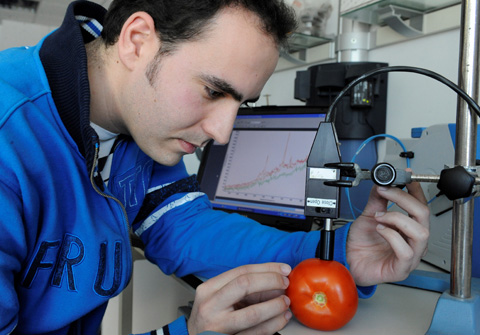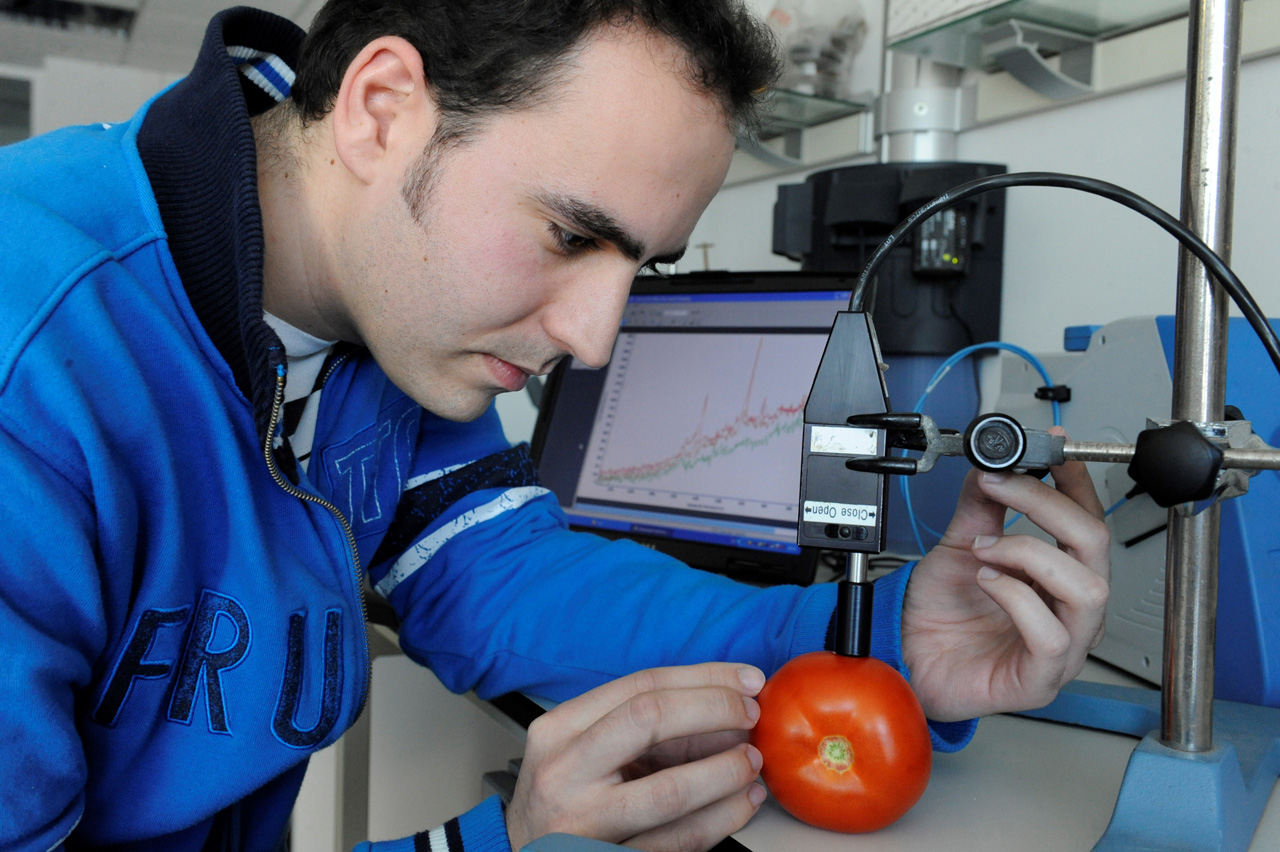Tomatoes ripen in various phases in which the colour of the fruit undergoes changes. A piece of research by the UPV/EHU's Department of Analytical Chemistry has used a portable Raman spectrometer, an instrument widely used in other fields such as analysing works of art, to monitor tomatoes. By using this mobile measuring device that analyses the molecular composition of the fruit, the producer can monitor tomatoes in situ and find out when they have reached their point of optimum ripeness.
A portable measuring device to detect optimum ripeness in tomatoes
A study by the UPV/EHU-University of the Basque Country is applying a portable device based on the Raman spectroscopy technique to monitor the ripeness of tomato fruits
First publication date: 09/05/2017

The portable Raman spectrometer, a device used in very different fields such as metallurgy, archaeology and art, allows data to be obtained on the variation in the composition of the tomato fruit during its various ripening phases, according to the results of a study conducted in the UPV/EHU's Department of Analytical Chemistry. The portable Raman spectrometer is an instrument widely used in a whole range of sectors, because it is a non-invasive technique that can be used, for example, to observe the pigments present in a painting or a sculpture without having to extract any samples, thus preserving the integrity of the work in question. In this case, a research team of the UPV/EHU has applied this equipment to culinary research. According to Josu Trebolazabala, the author of the study, "it is about transferring this technology, which had a specific use, to the kitchen. Our idea was to come up with a tool that could help producers find out when their tomatoes have reached their optimum ripeness point. This is achieved by using this technique and, what is more, without destroying the fruit".
The results provided by this portable instrument have been compared with those provided by a similar laboratory instrument, and "even though the quality of the Raman spectra of the lab instrument was higher, the quality of the information provided by the portable instrument could be regarded as sufficient for the aim in mind. The aim is to enable producers to go to the vegetable plot with this equipment, place the Raman probe on the tomato, and find out whether it is at its optimum picking point or whether it needs to be left longer so that it can ripen properly," said Jose Trebolazabala.
Tomato ripening
The monitoring of the composition of the tomato fruit during its ripening phases has made it possible to observe the changes that take place in the composition of the tomato during its passage from an unripe state towards a ripe state. "When the tomato is green, the main pigments are chlorophyll (hence its green colour) and the waxy cuticles, which are on the outside," explained Trebolazabala. But the presence of these compounds falls as the fruit reaches its point of optimum ripeness. "Once the colour changes to orange-coloured, compounds of a different type are observed; the carotenoid compounds are activated. The tomato gradually acquires nutrients until it reaches its optimum point, in other words, when the lycopene (the red carotenoid) is at its maximum level. After that, the tomato begins to lose its carotenoid content, as shown by the analyses conducted on overripe tomatoes".
This innovative technique can be extrapolated to any other food that changes colour during its ripening phase. "Tests have been carried out on peppers and pumpkins, for example, and it is also possible to obtain the data on their composition," he explained.
Additional information
Josu Trebolazabala conducted this study in the IBeA research group in the UPV/EHU's Department of Analytical Chemistry. This group has been conducting basic research work and collaborating in the technological development and innovation of many companies since 1987.
Bibliographic reference
- Portable Raman spectroscopy for an in-situ monitoring the ripening of tomato (Solanum lycopersicum) fruits
- Spectrochimica Acta Part A: Molecular and Biomolecular Spectroscopy (2017; Volume 180: Pages 138-143)
- DOI: 10.1016/j.saa.2017.03.024



